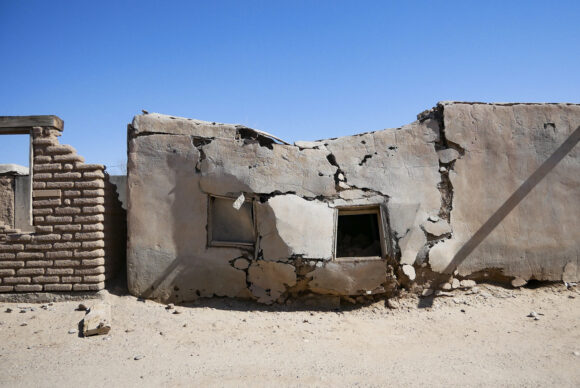SANTO DOMINGO PUEBLO, N.M. (AP) — First came the hail — sheets of it, pounding the centuries-old adobe homes at Santo Domingo Pueblo.
Roofs were perforated “like a machine gun,” with some vigas broken and windows shattered.
The floods came three years later — a week’s worth of rain, capped with a 24-hour downpour. In the ensuing years, mold issues arrived.
Diane Garcia and her daughter, Patricia, have lived amid the damage to their home since the 2010 hailstorm and 2013 deluge. They aren’t alone: Many other residents in the small pueblo southwest of Santa Fe continue to live in storm-damaged adobe homes.
But on a sunny Tuesday morning, the Garcias welcomed neighbors, government officials and media into their rebuilt adobe, the first completed project of 160 damaged homes in the historic village the pueblo intends to repair and rebuild as funding becomes available.
“We love it,” Patricia Garcia said. “We’re very thankful for the help we had.”
Since 2017, Santo Domingo Pueblo has spent $300,000 in tribal funds to repair about 30 roofs, the Santa Fe New Mexican reported. The Federal Emergency Management Agency kicked in $1.4 million, but there were so many restrictions that only $10,000 has been used so far, said Phoebe Suina, a San Felipe and Cochiti Pueblo member and owner of High Water Mark, a Bernalillo environmental consulting company and project manager for Santo Domingo’s housing project.
But a turning point came in late 2019 when Gov. Michelle Lujan Grisham invited Santo Domingo tribal leaders to discuss their plight. Just before the coronavirus pandemic hit, Lujan Grisham sent her Cabinet secretaries to the dirt roads and adobe homes of the pueblo’s historic village, where homes are typically more than 100 years old and some date to the 1600s and 1700s.
“Gov. (Lujan) Grisham invited us,” former Santo Domingo Gov. Thomas Moquino recalled. “We sat down with our wants. She opened her ears, listened to us.”
“The leadership here is to be commended for its persistence,” New Mexico Indian Affairs Department Secretary Lynn Trujillo said of the tribal council’s persistence in seeking state and federal aid. “Out of something really bad comes something really good. Out of the pandemic came opportunity.”
The state committed $2 million in state funding and $1.4 million in federal CARES Act money to help restore the historic village after setting aside $28 million in CARES funds for New Mexico’s tribal communities. Santo Domingo Pueblo has spent or committed the full amount to restoring the first eight storm-damaged homes by summer, Suina said.
Diane and Patricia Garcia intend to move into their new adobe home by mid-April. Doing so will end nearly a decade of living with rain and roof damage, which was worst in the kitchen.
“On rainy days, it was the hardest,” said Patricia Garcia. “It seemed like it rained all the time. It’s just as hard when it snowed and the snow melted.”
Once the state money arrived, the tribe wanted to quickly start restoring and rebuilding homes. Santo Domingo found Albuquerque architect Elizabeth Suina, a neighboring Cochiti Pueblo member with no relation to Phoebe Suina. She enlisted licensed contractor Ty Perry, and they created Arrowhead Construction to build the first eight homes. Construction involved creating the mud-and-straw bricks for adobe, said Herman Sanchez, tribal programs administrator for Santo Domingo Pueblo.
“It was important to us that, if possible, a Native-owned company was hired to oversee this project,” Sanchez said. “We have the capability now to start our own company.”
The tribe estimates the full restoration of all 160 storm-damaged homes could cost $40 million. The Garcia home cost about $300,000, Sanchez said.
Thankful that a new day had dawned, leaders at Santo Domingo Pueblo _ also known by its traditional name Kewa Pueblo _ recounted the decade-long journey of weather havoc and state and federal governments’ seeming indifference to their plight.
“We looked for help,” council member Ramos Pacheco said. “We are not a gaming tribe. They ignored us. We’ve been asking for help since before (former Gov. Susana) Martinez.”
Trujillo said the state Indian Affairs Department budget allocated $20,000 and later $50,000 to Santo Domingo Pueblo for technical assistance to launch the project last year.
“The citizens of Kewa Pueblo are citizens of the state,” she said. “We should be helping them as we help all New Mexicans.”
Jennifer Pruett, deputy secretary of the state Environment Department, was among those who visited seven of the pueblo’s damaged homes a year ago. She returned for the open house at the Garcia home.
“It was horrible what I saw,” Pruett said of the damage she saw during her first visit. “There are also improvements needed with water and wastewater infrastructure.”
Sammy Garcia, another former Santo Domingo governor, said he still has vivid memories of the 2010 hailstorm.
“Terrible. You couldn’t even see through the hail,” Garcia said. “People were crying. There were holes in the roofs, windows were shattered. `What’s happening to us?”’
But that was then. During the recent open house celebration, all anyone could talk about was a sunny day. A new day.
About the photo: This March 30, 2021 image shows the wall of a traditional adobe home caving in at Santo Domingo Pueblo, New Mexico, due to flood and hail damage. An initiative to restore and rebuild traditional homes within the pueblo is underway with the help of federal and state funds. (Matt Dahlseid/Santa Fe New Mexican via AP)
Was this article valuable?
Here are more articles you may enjoy.


 AF Group Claims Exec Embracing AI, But He Won’t Measure Success by Replacing People
AF Group Claims Exec Embracing AI, But He Won’t Measure Success by Replacing People  Fixing the Claims Experience Where It Matters Most: In the Mess
Fixing the Claims Experience Where It Matters Most: In the Mess  DIY Home Inspections? They Are Taking Over, Firms Say
DIY Home Inspections? They Are Taking Over, Firms Say  Plane Crashes into San Diego Neighborhood, Setting Homes And Vehicles on Fire
Plane Crashes into San Diego Neighborhood, Setting Homes And Vehicles on Fire 